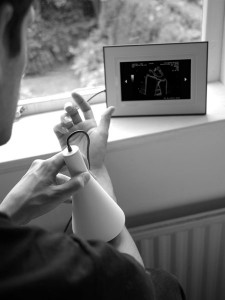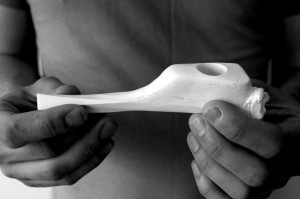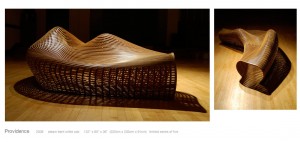Tim Blackwell’s Swarm Music (2001-2002):
Swarm Music
In a few different series of compositions, Tim Blackwell uses swarming and flocking algorithms to generate music. He explains that in an ensemble that is improvising is essentially performing a sort of flocking behavior, wherein the entire group as a whole is moving in some direction, led by the musicians responding to each other. Based on these principles, he synthesizes MIDI compositions in which the instruments swarm/flock to create music.
Overall, what attracted me to this piece was the idea of creating a composition in the same way jazz improvisers create music, with each voice in an ensemble responding to the others. I think this work is quite successful, although I wish these pieces were updated with modern synthesizers. It’s very clear from listening to these decade-old compositions that MIDI and other synthesized audio technologies have come a long, long way in the last ten years.
Jon McCormack’s Morphogenesis Series (2011):
Link to series
This series of digital prints synthesizes flora using genetic algorithms, with Australian flora as a starting point. He notes that the types of flora that were produced from this series had familiar characteristics, yet would probably be impossible in nature. He seems to use a nice renderer/shader to go from the models that are created, as shown in a detailed image on the site linked above, to the final version.
The idea of synthesizing biological creatures that are familiar yet impossible is an attractive idea, and I think McCormack executes it well. As someone who’s not familiar with Australian flora, I perhaps can’t appreciate all of the subtlety of what was produced by the genetic algorithm, as opposed to what actually is characteristic of Australia. Regardless, I think the images are very pretty, and I would appreciate seeing these printed out rather than on a computer monitor. (There are prints available). I think mediating this sort of art with a screen, even though it was created on a device whose interaction with us is mediated by such a screen, doesn’t do as much justice to the images as printing them out on high quality paper might.


Deborah Kelly, Beastlines (2011)
Link to Beastlines videos
Beastlines is a series of short animations taking biological mashups, in a cut-and-paste style, and animating them. In essence, it’s a commentary on new lifeforms and genetically mutated life. It takes the opposite approach from the two other projects I’ve looked outwards towards today. From the artist’s description, I think the most striking phrase used it “biology is no longer destiny.” It seems that this phrase is a major driver in this work, animating biological deviations.
On its own, I think the individual figures aren’t very striking. However, in animation, taking on bizarrely human and dance characteristics, I think this piece becomes more compelling. There are a few moments when the characters seem to be dancing, juxtaposing their distinctly mashed-up, non-human form with what I perceive as an inherently human movement.













